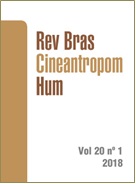Imagem corporal e indicadores antropométricos em adolescentes vivendo com HIV
DOI:
https://doi.org/10.1590/1980-0037.2018v20n1p53Resumo
Objetivou-se comparar a imagem corporal e os indicadores antropométricos entre adolescentes vivendo com HIV e sem o diagnóstico da infecção (grupo controle). Além disso, foram testadas associações entre variáveis antropométricas, infecção / tratamento, maturação sexual e sociodemográficas com a imagem corporal em adolescentes vivendo com HIV. Participaram 111 adolescentes com idade de 10 a 15 anos, divididos em adolescentes que vivem com HIV (n = 57) e controles (n = 54). A imagem corporal foi investigada a partir da escala de oito silhuetas corporais. As medidas antropométricas realizadas foram massa corporal, estatura, perímetros e dobras cutâneas. Foi encontrado que 54,4% dos adolescentes que vivem com o HIV estavam insatisfeitos com a imagem corporal, sendo que 38,6% indicaram insatisfação por magreza. Por outro lado, adolescentes do grupo controle demonstraram insatisfação com a imagem corporal por excesso de peso (40,74%). Não foi encontrada diferença entre o grupo HIV e controle para os indicadores antropométricos analisados. O sexo (? = -0,52), a idade (? = 0,18), a massa corporal (? = 0,07), o índice de massa corporal (? = -0,19) e a área muscular do braço (? = -0,08) explicaram 42% da variação do escore de imagem corporal em adolescentes que vivem com HIV. A insatisfação com a imagem corporal no grupo HIV é apontada pela magreza e no controle pelo excesso de peso. Quase metade da variação da imagem corporal dos adolescentes que vivem com HIV foi explicada pelas variáveis demográficas e antropométricas.
Downloads
Publicado
Edição
Seção
Licença

Direitos Autorais para artigos publicados nesta revista são do autor, com direitos de primeira publicação para a revista. Em virtude da aparecerem nesta revista de acesso público, os artigos são de uso gratuito, com atribuições próprias, em aplicações educacionais e não-comerciais, desde que seja dada a atribuição. Esta obra foi licenciada com uma Licença Creative Commons Atribuição 4.0 Internacional - CC BY


